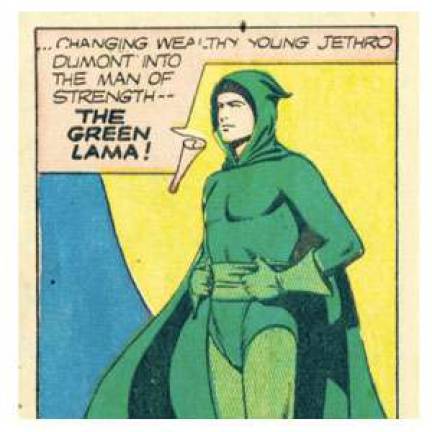Karma Komix

Visitors entering the lobby of the Rubin Museum of Art are welcomed with soothing Eastern music played by live performers nestled in the curved foot of an elegant spiral staircase-the building is itself a landmarked structure created by the noted French architectural designer Andrée Putman for Barney's, its previous incarnation-that rises six levels through galleries of priceless permanent collections and traveling exhibitions from countries bordering the 1,800-mile arc of the Himalayan mountain range. For the Sherpa-challenged, an elevator is recommended for the ascent to the top; take the stylish stairway down to see the exhibitions.
The Rubin is the most user-friendly museum in the city; I know of no other that encourages the visitor to slide one of its small padded benches over and sit in unhurried contemplation before the thangkha painting of one's choice.
Spiraling all the way down to the lower level, one enters the realm of Hero, Villain, Yeti: Tibet in Comics, an extraordinary exhibition of vintage comic books and early action figures that, in keeping with the Buddhist principles of lineage and reincarnation, is the most complete and comprehensive collection of comics related to Tibet ever assembled.
Curated by Dr. Martin Brauen, anthropologist, religious historian, author of several English-language and German publications on Tibetan and Himalayan art and culture and chief curator of the Rubin from 2008 to 2011, the exhibit includes comics from Germany, France, Belgium (The Adventures of Tintin), Italy, India and Japan, in their original languages and translated into English, some for the first time. They are presented for easy perusal in facsimile format in bound albums on a broad table flanked by stools. Headphones are also available for the enjoyment of a video narrated by Brauen.
How could a mysterious country surrounded by the world's highest, most perilous snow-covered mountains-the impenetrable "roof of the world"-inspire such fantastic stories?
Walt Disney fell under the influence, too, as shown in Walt Disney presents Mickey Mouse in High Tibet and Donald Duck and Uncle Scrooge in Tralala, the Roof of the World, accompanied by Bugs Bunny and Porky Pig frolicking in the snow. There were serious heroes, of course-Doctor Strange, Master of the Mystical Arts; The Green Lama, the Man Who Defies Death; Dalai Lama: Superhero-and here we see Flash Gordon and the beginnings of Batman, Iron Man and a lithe Tomb Raider Lara Croft, as well as sinister villains, as in Pharoan, where Nazi agents go to Tibet in search of occult secrets to advance Hitler's doctrines. Sometimes there was an unfriendly crossover, where a villain could turn nasty: "It's the Green Lama!! Get him boys!!" commands a really pissed off Bugs Bunny.
The popularity of comics gave birth to action figures, and some are displayed here: Mickey Mouse and Donald Duck were proto-action figures but are not as scary as the tiny caped Doctor Strange. As for the Yetis, how long can a snowman stay abominable? My guess is that the Yeti evolved from the comics into an industry of its own, encompassing more dependably articulated movie icons like King Kong, Chewbacca, Yoda, vampires and lumbering, uncuddly robots.
Hero, Villain, Yeti: Tibet in Comics Through June 11, Rubin Museum of Art, 150 W. 17th St., 212-620-5000, www.rmanyc.org.